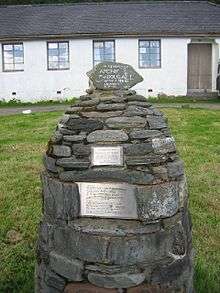Seven Men of Knoydart
The Seven Men of Knoydart was the name given to a group of squatters who tried to appropriate land at Knoydart in 1948[1] by the press at the time, evoking the memory of the seven Jacobites who accompanied the Young Pretender on his voyage to Scotland in 1745.[2] Comprising seven ex-servicemen, their claim was to be the last land raid in Scotland.[3]
History
At the end of the 18th-century, a population of around 1,000 eked out a living on the Knoydart peninsula, through a mixture of crofting and fishing.[4] Depopulation of the area began in August 1853, when the recently widowed Josephine MacDonnell forced the eviction of some 330 people to Canada, on board the Sillery, to make way for sheep.[5] Depopulation of the area continued with a series of evictions as successive landowners ran the property as a hunting and shooting estate.[4]
Land raid
By 1948 Knoydart was under the ownership of the infamous Lord Brocket. On the 9th November,[2] the seven men, Henry MacAskill, Archie MacDonald, Archie MacDougall, Jack MacHardy, Duncan McPhail, Sandy Macphee and William Quinnall,[6] invoking the Land Settlement Act, which permitted returning servicemen to take over land which was under-used and farm it as their own, marked out 65 acres (26 hectares) of arable land and 10,000 acres (4,000 hectares) of hill land upon which to settle.[5]
The raid followed a pattern set by the Highland Land League some seventy years before, and inspired by similar land-raids at the end of the Great War on Raasay and the Long Isle, when returning soldiers drew public attention to the misuse and mismanagement of land.[2]

Lord Brocket applied for a court order to remove them.[5] The case was heard and rejected by a Court of Enquiry called by the government early in 1949. An appeal to the Secretary of State also failed.[2]
A cairn commemorating the land raid was erected at Inverie in 1991, by the Knoydart Land Raid Commemoration Committee.[7] The plaque reads:
- Justice!
- In 1948 near this cairn the Seven Men of Knoydart staked claims to secure a place to live and work.
- For over a century Highlanders had been forced to use land raids to gain a foothold where their forebears lived. Their struggle should inspire each new generation of Scots to gain such rights by just laws.
- History will judge harshly the oppressive laws that have led to the virtual extinction of a unique culture from this beautiful place. [8]
Legacy
The reign of absentee landlords in Knoydart came to an end in the 1980s, when Surrey property dealer Phillip Rhodes acquired the estate and began selling off sections. The last 17,000 acres were bought by Jute manufacturing company Titaghur, and when the company went into receivership the land was acquired by the Knoydart Foundation in a community led buy-out.[5]
References
- ↑ Miers, R. (2006) Scotland's Highlands and Islands page 115 New Holland Publishers. ISBN 1860113400 Retrieved MArch 2015
- 1 2 3 4 Prebble, J. (2012) John Prebble's Scotland page 77-78 Pan Macmillan. ISBN 1447233794 Retrieved March 2015
- ↑ Skinner, S.J. (1999) Maverick Guide to Scotland page 506 Pelican Publishing. ISBN 1455608661 Retrieved March 2015
- 1 2 Humphreys, R. & Reid, D. (2013) The Rough Guide to Scottish Highlands & Islands (6th Ed.) page 236 Rough Guides UK. ISBN 1409351645 Retrieved March 2015
- 1 2 3 4 Sandison, B. (2012) Sandison's Scotland page 194-195 Black & White Publishing ISBN 1845025709 Retrieved March 2015
- ↑ Dick Gaughan's Song Archive The Seven Men (notes)
- ↑ Skinner, J.S. (1999) Maverick Guide to Scotland Pelican Publishing. ISBN 1455608661 Retrieved March 2015
- ↑ Scott, A. (2015) Native Stranger: A Journey in Familiar and Foreign Scotland page 343 Hachette UK. ISBN 0751561223 Retrieved March 2015